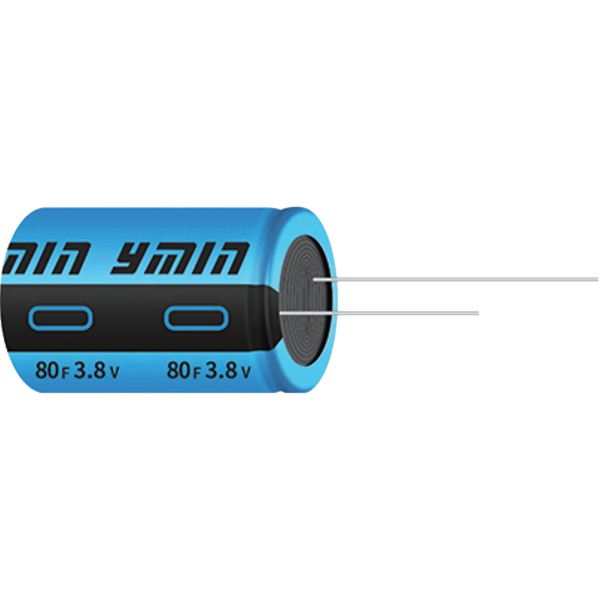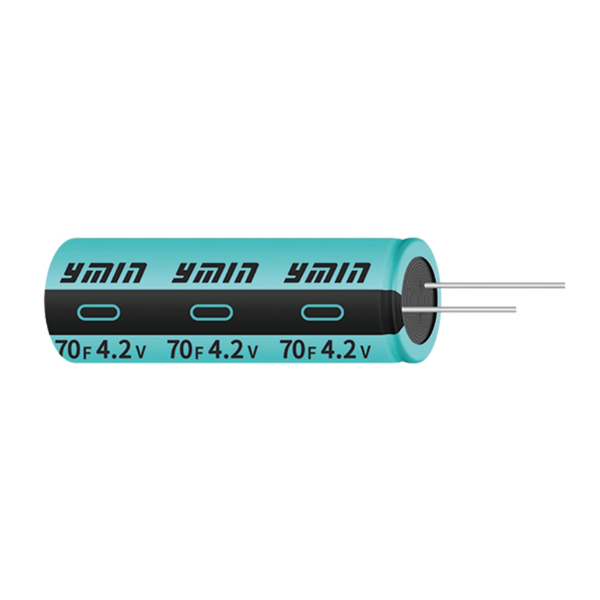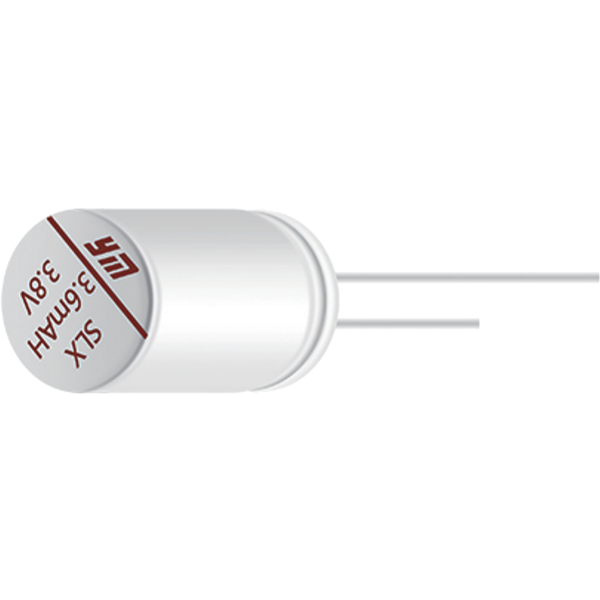Main Technical Parameters
| project | characteristic | |
| temperature range | -40~+90℃ | |
| Rated voltage | 3.8V-2.5V, maximum charging voltage: 4.2V | |
| Electrostatic capacity range | -10%~+30%(20℃) | |
| Durability | After continuously applying rated voltage (3.8V) at +90℃ for 1000 hours, when returning to 20℃ for testing, the following items must be met: | |
| Electrostatic capacitance change rate | Within ±30% of initial value | |
| ESR | Less than 4 times the initial standard value | |
| High temperature storage characteristics | After being placed at +90℃ for 1000 hours without load, when returned to 20℃ for testing, the following items must be met: | |
| Electrostatic capacitance change rate | Within ±30% of initial value | |
| ESR | Less than 4 times the initial standard value | |
Product Dimensional Drawing
Physical Dimension(unit:mm)
|
L≤16 |
a=1.5 |
|
L>16 |
a=2.0 |
|
D |
6.3 |
8 |
10 |
12.5 |
|
d |
0.5 |
0.6 |
0.6 |
0.6 |
| F |
2.5 |
3.5 |
5 |
5 |
The Main Purpose
♦ETC(OBU)
♦Driving recorder
♦T-BOX
♦Vehicle monitoring
Lithium-ion capacitors (LICs) are a novel type of electronic component with a structure and working principle distinct from traditional capacitors and lithium-ion batteries. They utilize the movement of lithium ions in an electrolyte to store charge, offering high energy density, long cycle life, and rapid charge-discharge capabilities. Compared to conventional capacitors and lithium-ion batteries, LICs feature higher energy density and faster charge-discharge rates, making them widely regarded as a significant breakthrough in future energy storage.
Applications:
- Electric Vehicles (EVs): With the increasing global demand for clean energy, LICs are widely used in the power systems of electric vehicles. Their high energy density and rapid charge-discharge characteristics enable EVs to achieve longer driving ranges and faster charging speeds, accelerating the adoption and proliferation of electric vehicles.
- Renewable Energy Storage: LICs are also utilized for storing solar and wind energy. By converting renewable energy into electricity and storing it in LICs, efficient utilization and stable supply of energy are achieved, promoting the development and application of renewable energy.
- Mobile Electronic Devices: Due to their high energy density and rapid charge-discharge capabilities, LICs are extensively used in mobile electronic devices such as smartphones, tablets, and portable electronic gadgets. They provide longer battery life and faster charging speeds, enhancing the user experience and portability of mobile electronic devices.
- Energy Storage Systems: In energy storage systems, LICs are employed for load balancing, peak shaving, and providing backup power. Their fast response and reliability make LICs an ideal choice for energy storage systems, improving grid stability and reliability.
Advantages over Other Capacitors:
- High Energy Density: LICs possess higher energy density than traditional capacitors, enabling them to store more electrical energy in a smaller volume, resulting in more efficient energy utilization.
- Rapid Charge-Discharge: Compared to lithium-ion batteries and conventional capacitors, LICs offer faster charge-discharge rates, allowing for quicker charging and discharging to meet the demand for high-speed charging and high-power output.
- Long Cycle Life: LICs have a long cycle life, capable of undergoing thousands of charge-discharge cycles without performance degradation, resulting in extended lifespan and lower maintenance costs.
- Environmental Friendliness and Safety: Unlike traditional nickel-cadmium batteries and lithium cobalt oxide batteries, LICs are free from heavy metals and toxic substances, exhibiting higher environmental friendliness and safety, thereby reducing environmental pollution and the risk of battery explosions.
Conclusion:
As a novel energy storage device, lithium-ion capacitors hold vast application prospects and significant market potential. Their high energy density, rapid charge-discharge capabilities, long cycle life, and environmental safety advantages make them a crucial technological breakthrough in future energy storage. They are poised to play a vital role in advancing the transition to clean energy and enhancing energy utilization efficiency.
| Products Number | Working Temperature (℃) | Rated Voltage (Vdc) | Capacitance (F) | Width (mm) | Diameter(mm) | Length (mm) | Capacity (mAH) | ESR (mΩmax) | 72 hours leakage current (μA) | Life (hrs) | Certification |
| SLAH3R8L1560613 | -40~90 | 3.8 | 15 | - | 6.3 | 13 | 5 | 800 | 2 | 1000 | AEC-Q200 |
| SLAH3R8L2060813 | -40~90 | 3.8 | 20 | - | 8 | 13 | 10 | 500 | 2 | 1000 | AEC-Q200 |
| SLAH3R8L4060820 | -40~90 | 3.8 | 40 | - | 8 | 20 | 15 | 200 | 3 | 1000 | AEC-Q200 |
| SLAH3R8L6061313 | -40~90 | 3.8 | 60 | - | 12.5 | 13 | 20 | 160 | 4 | 1000 | AEC-Q200 |
| SLAH3R8L8061020 | -40~90 | 3.8 | 80 | - | 10 | 20 | 30 | 150 | 5 | 1000 | AEC-Q200 |
| SLAH3R8L1271030 | -40~90 | 3.8 | 120 | - | 10 | 30 | 45 | 100 | 5 | 1000 | AEC-Q200 |
| SLAH3R8L1271320 | -40~90 | 3.8 | 120 | - | 12.5 | 20 | 45 | 100 | 5 | 1000 | AEC-Q200 |
| SLAH3R8L1571035 | -40~90 | 3.8 | 150 | - | 10 | 35 | 55 | 100 | 5 | 1000 | AEC-Q200 |
| SLAH3R8L1871040 | -40~90 | 3.8 | 180 | - | 10 | 40 | 65 | 100 | 5 | 1000 | AEC-Q200 |
| SLAH3R8L2071330 | -40~90 | 3.8 | 200 | - | 12.5 | 30 | 70 | 80 | 5 | 1000 | AEC-Q200 |
| SLAH3R8L2571335 | -40~90 | 3.8 | 250 | - | 12.5 | 35 | 90 | 50 | 6 | 1000 | AEC-Q200 |
| SLAH3R8L2571620 | -40~90 | 3.8 | 250 | - | 16 | 20 | 90 | 50 | 6 | 1000 | AEC-Q200 |
| SLAH3R8L3071340 | -40~90 | 3.8 | 300 | - | 12.5 | 40 | 100 | 50 | 8 | 1000 | AEC-Q200 |
.png)
-300x300.png)



